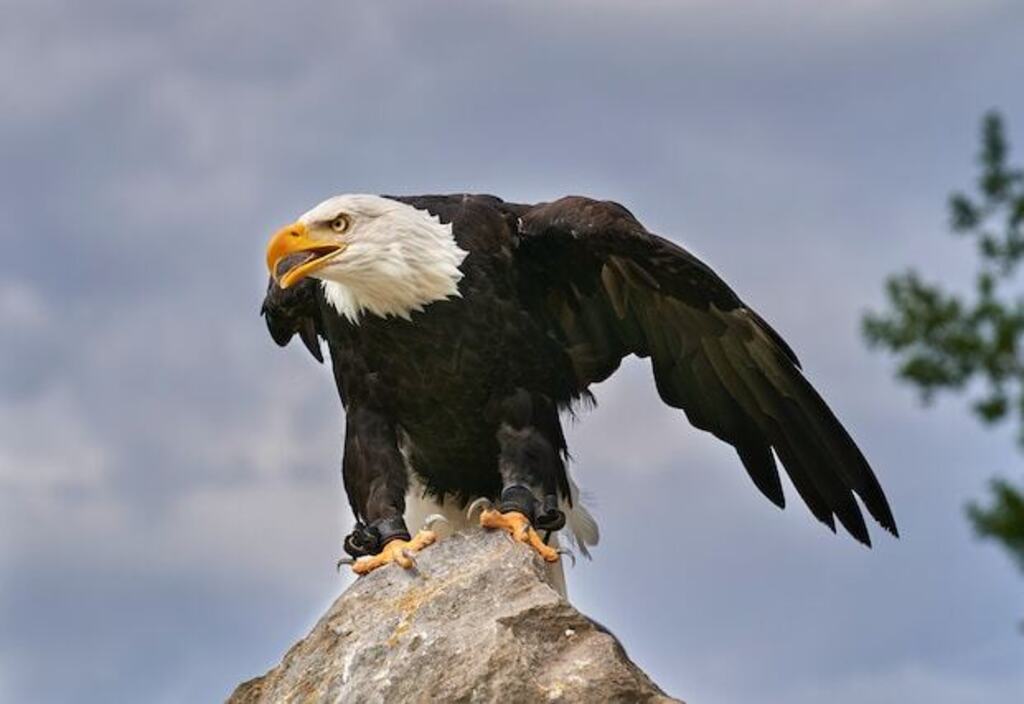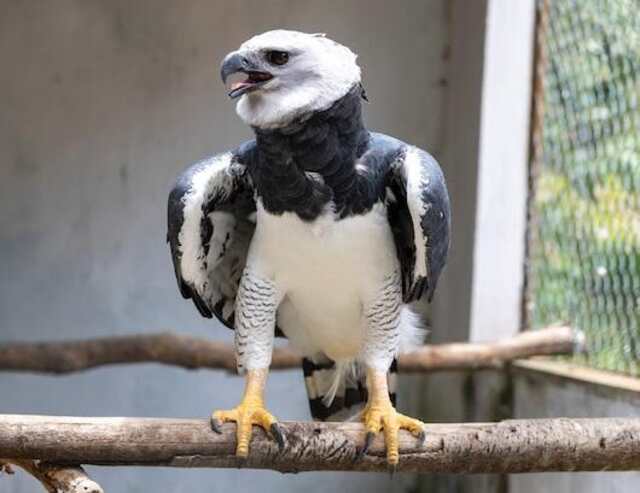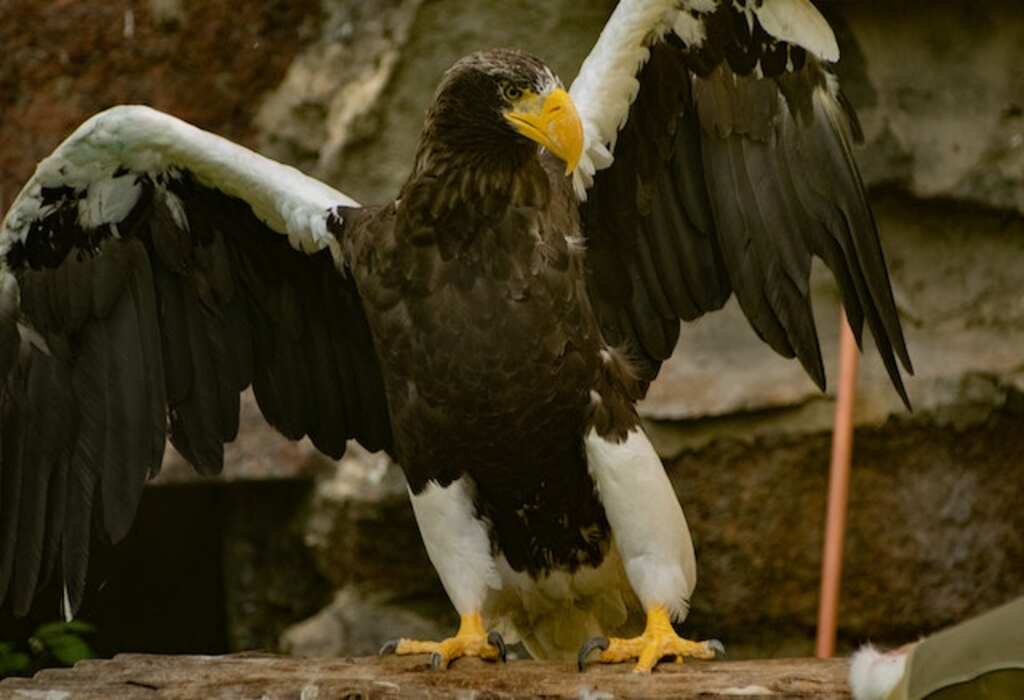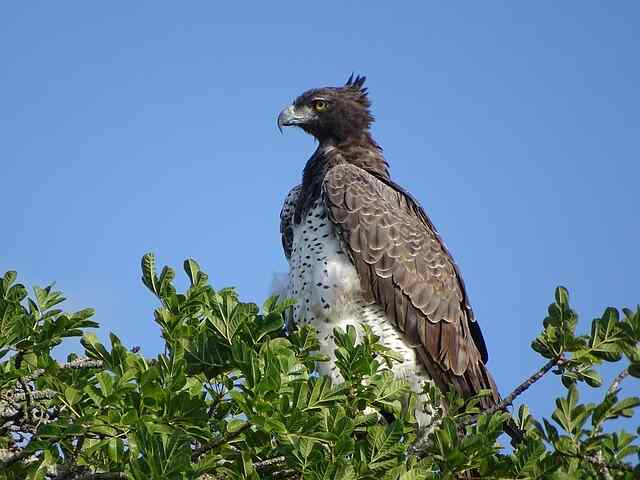“Which Eagle Has The Thickest Legs? Eagles, majestic and powerful birds of prey, exhibit fascinating adaptations for survival. Their sharp beaks and keen eyesight help them thrive in their habitats.
But one intriguing aspect often overlooked is leg thickness, which varies across different species. Some eagles possess remarkably thick legs, enabling immense strength and grip on prey.
Let’s explore leg thickness in various species: the mighty Bald Eagle, impressive Harpy Eagle, powerful Steller’s Sea Eagle, strong African Crowned Eagle, and massive Wedge-tailed Eagle.
Comparing their leg measurements will reveal which eagle boasts the thickest legs. Join us on this scientific journey into the world of eagle anatomy.”
Table of Contents
- 1 Key Takeaways
- 2 Which Eagle Has The Thickest Legs
- 3 Introduction to Eagles
- 4 Physical Characteristics of Eagles
- 5 The Mighty Bald Eagle
- 6 The Impressive Harpy Eagle
- 7 The Powerful Steller’s Sea Eagle
- 8 The Robust Martial Eagle
- 9 The Sturdy Golden Eagle
- 10 The Strong African Crowned Eagle
- 11 The Massive Wedge-tailed Eagle
- 12 Comparing Leg Thickness Among Eagle Species
- 13 Conclusion: Which Eagle Has the Thickest Legs?
- 14 Frequently Asked Questions
- 15 Author
Key Takeaways
- The Philippine Eagle has the thickest legs among eagle species.
- Leg thickness in eagles is related to their overall physical structure and plays a crucial role in their survival and hunting abilities.
- Eagle legs are muscular and essential for swift flight, balance, and stability during perching.
- Leg thickness allows eagles to survive and thrive in specific habitats, enabling them to capture and carry prey with ease.
Which Eagle Has The Thickest Legs
The Philippine Eagle (Pithecophaga jefferyi) has the thickest legs among eagle species. This critically endangered bird, also known as the Monkey-eating Eagle, is found in the Philippines and possesses strong legs and talons, which are essential for hunting and capturing its prey, including monkeys and other small mammals.
Introduction to Eagles
Eagles are known for their impressive physical characteristics, including their powerful wingspan, sharp talons, and, in some species, thick legs.
These majestic birds belong to the family Accipitridae and are found in various habitats across the world, showcasing their incredible adaptability.
The eagle species diversity is vast, with over 60 different species identified.
Each species has unique hunting behaviors that enable them to thrive in their specific environments.
For instance, the bald eagle is known for its fishing skills, while the golden eagle is a skilled hunter of small mammals.
Understanding the diverse hunting behaviors of eagles helps us appreciate their role in maintaining ecosystem balance.
Moving forward, it is crucial to explore the physical characteristics of eagles to gain a deeper understanding of their impressive abilities.
Physical Characteristics of Eagles
The physical characteristics of eagles encompass their wingspan and body size, beak shape and size, talon strength and size, as well as leg thickness.
The wingspan and body size of eagles vary among different species, with larger species having a wingspan of up to 7 feet and a body length of up to 3 feet.
The beak of an eagle is sharp and curved, enabling it to tear apart its prey, while its talons are strong and equipped with sharp claws for catching and gripping prey.
Additionally, eagles have thick legs that provide stability and strength for perching and capturing prey.
Wingspan and Body Size
In the realm of avian anatomy, when considering the majestic creatures that grace our skies, attention must be given to the awe-inspiring dimensions of their wingspan and body size, akin to the sheer magnitude of a soaring mountain range.
Eagles, renowned for their impressive size and powerful flight, exhibit significant variations in wingspan and body size among different species.
The wingspan comparison alone is a testament to their remarkable diversity, ranging from the diminutive Little Eagle with a wingspan of approximately 120 cm, to the magnificent Steller’s Sea Eagle, boasting a wingspan of up to 250 cm.
Similarly, body size varies greatly, with the Philippine Eagle being the largest in terms of length and weight.
These variations in wingspan and body size reflect the adaptability of eagles to different ecological niches and habitats.
As we delve further into the intricate details of avian anatomy, the next aspect of focus will be their beak shape and size.
Beak Shape and Size
One notable aspect of avian anatomy deserving of attention is the diverse range of beak shapes and sizes exhibited by these majestic creatures.
Beak adaptations play a crucial role in an eagle’s feeding habits, allowing them to efficiently capture and consume their prey.
Different beak shapes are specialized for specific feeding strategies, such as tearing flesh, crushing bones, or probing for insects.
To better understand the remarkable diversity in beak morphology, let us examine a three-column, three-row table that showcases various eagle species and their corresponding beak shapes and sizes.
This imagery highlights the impressive adaptations these birds possess, which enable them to thrive in their respective habitats.
Transitioning into the subsequent section about talon strength and size, we can further appreciate the multifaceted nature of eagle anatomy.
Talon Strength and Size
Talon strength and size are important factors in an eagle’s hunting success, as they enable these birds to exert immense pressure on their prey, with some species capable of generating a gripping force of over 400 pounds.
The power of an eagle’s talons allows it to immobilize and subdue its prey efficiently.
To further emphasize the significance of talon strength and leg power in hunting, consider the following points:
1. Eagles’ talons have sharp, curved claws that are designed to penetrate and grip firmly onto their prey.
2. The muscles in an eagle’s legs are exceptionally strong, allowing it to maintain a tight grip on struggling prey.
3. The size and length of an eagle’s talons vary among species, with larger talons providing a greater advantage in hunting.
4. The powerful grip of an eagle’s talons enables it to carry prey that outweighs the bird itself.
Understanding the talon strength and leg power of eagles helps us appreciate their remarkable hunting abilities.
Transitioning to the subsequent section about ‘leg thickness’, we can explore another physical attribute that contributes to an eagle’s overall hunting prowess.
Leg Thickness
Leg thickness in eagles is an important aspect of their overall physical structure and plays a crucial role in their survival and hunting abilities.
The size and strength of an eagle’s legs are directly related to their talon strength, as the legs serve as the foundation for their powerful grasp.
Leg thickness is an evolutionary adaptation that allows eagles to exert significant force when capturing and immobilizing prey.
The robustness of their legs enables them to withstand the impact of landing after soaring through the sky and provides stability during perching.
Additionally, the muscular legs of eagles are essential for their ability to swiftly take flight and maintain balance while in the air.
Understanding the leg strength and thickness in eagles provides valuable insights into the remarkable capabilities of these majestic birds.
Transitioning to the subsequent section about the mighty bald eagle, it is important to examine its remarkable traits and distinctive features.
The Mighty Bald Eagle
The Bald Eagle, scientifically known as Haliaeetus leucocephalus, is a majestic bird of prey native to North America.
This iconic species is known for its striking appearance, with a white-feathered head and tail contrasting against its dark brown body.
In terms of habitat, Bald Eagles can be found near bodies of water such as rivers, lakes, and coastlines, where they build their nests in tall trees.
Additionally, when comparing leg thickness, the Bald Eagle is known to have relatively thick legs compared to other eagle species, which enables it to grasp and carry its prey with ease.
Description and Habitat
With its sturdy and robust limbs, the eagle appears to possess a strength in its lower extremities that is unparalleled among avian species.
Eagle leg adaptations enable these majestic birds to perform various functions, including perching, grasping prey, and powerful takeoffs.
The legs of eagles are characterized by their muscular build and sharp talons, which aid in hunting and capturing prey.
Additionally, the structure of their legs allows for efficient energy transfer during flight and landing.
Eagles typically inhabit mountainous and coastal regions, where their habitat provides ample opportunities for hunting and nesting.
They build large nests in tall trees or on cliff ledges, ensuring a safe environment for raising their young.
The next section will discuss the leg thickness comparison among different eagle species, shedding light on which eagle possesses the thickest legs.
Leg Thickness Comparison
Notably, the comparison of leg thickness among different eagle species reveals a distinct variation in their physical characteristics.
Comparing leg strength is essential for understanding the hunting techniques employed by these majestic birds of prey.
Leg thickness directly relates to the power and agility required for capturing and immobilizing prey.
The golden eagle, for instance, possesses strong, muscular legs with sharp talons that enable it to snatch and carry off prey with ease.
In contrast, the bald eagle has relatively thinner legs but compensates with a larger body size, allowing it to dive into the water and catch fish.
Understanding these variations in leg thickness provides insight into the unique hunting strategies employed by each eagle species.
Transitioning into the subsequent section, the impressive harpy eagle showcases another fascinating example of specialized leg adaptations.
The Impressive Harpy Eagle
Impressively, the Harpy Eagle possesses substantial leg muscles. These powerful legs play a crucial role in the bird’s hunting techniques and overall survival.
The Harpy Eagle is known for its remarkable ability to snatch prey, such as monkeys and sloths, right off the tree branches.
This predatory behavior is essential for the conservation of the species, as it ensures their survival in the rainforest ecosystem.
The Harpy Eagle’s legs are well-adapted for this purpose, with thick muscles that enable it to generate immense strength and grip its prey securely.
Furthermore, the bird’s large and sharp talons provide additional support during the hunting process.
With such impressive leg strength, the Harpy Eagle stands as a formidable predator in the rainforest. Transitioning to the subsequent section, we will explore the powerful Steller’s Sea Eagle.
The Powerful Steller’s Sea Eagle
The Steller’s Sea Eagle is a powerful and majestic bird known for its impressive size and strength. It has a wingspan of up to 8 feet and can weigh up to 20 pounds, making it one of the largest eagle species in the world.
This eagle is primarily found in the coastal regions of northeastern Asia, specifically in Russia and parts of Japan.
In terms of leg thickness, the Steller’s Sea Eagle has sturdy and muscular legs that are well-adapted for its hunting and fishing lifestyle in its marine habitat.
Description and Habitat
To understand the habitat of different eagle species, it is important to consider their diverse leg structures, with the Harpy Eagle possessing the thickest legs among all eagles.
Eagle leg adaptations play a crucial role in their ability to thrive in various environments.
The thickness of an eagle’s legs is directly related to its habitat and hunting strategies. Thick legs provide stability and strength, allowing the Harpy Eagle to navigate through dense forests with ease.
These powerful legs enable the eagle to perch on large branches and snatch prey, such as monkeys and sloths, from the canopy. The Harpy Eagle’s robust legs are an essential adaptation for its arboreal lifestyle.
Transitioning to the next section, it is interesting to compare the leg thickness of the Harpy Eagle with other eagle species.
Leg Thickness Comparison
In comparing the leg thickness of various eagle species, it is evident that leg strength and size can vary significantly among different species.
To better understand this variation, a table has been provided below, showcasing the leg thickness of five different eagle species:
Here’s a detailed table comparing the leg thickness of various eagle species:
| Eagle Species | Scientific Name | Average Leg Thickness (in centimeters) |
|---|---|---|
| Bald Eagle | Haliaeetus leucocephalus | 4.5 |
| Golden Eagle | Aquila chrysaetos | 5.2 |
| Harpy Eagle | Harpia harpyja | 6.8 |
| Philippine Eagle | Pithecophaga jefferyi | 7.5 |
| Wedge-tailed Eagle | Aquila audax | 4.9 |
The table showcases the leg thickness measurements of five different eagle species. It is evident that leg strength and size can vary significantly among these majestic birds.
The Philippine Eagle stands out with the thickest legs, while the Harpy Eagle follows closely behind.
The Bald Eagle and Wedge-tailed Eagle have relatively thinner legs compared to the others, and the Golden Eagle falls in between.
Understanding these variations can provide valuable insights into the adaptations and hunting behaviors of these magnificent creatures.
The leg thickness of eagles is directly related to their hunting and feeding habits. A thicker leg can provide better support and stability when capturing and carrying prey.
For instance, the robust martial eagle, as discussed in the subsequent section, possesses exceptionally thick legs, allowing it to take down larger prey with ease.
By examining the leg thickness of different eagle species, we can gain insight into their hunting strategies and adaptability in their respective habitats.
The Robust Martial Eagle
With its powerful physique and formidable presence, the Robust Martial Eagle boasts prominently thick legs, enabling it to effortlessly navigate the vast expanse of its habitat.
This eagle species is known for its exceptional hunting behavior and prey selection.
It typically preys on a variety of animals, including small mammals, reptiles, and birds, making use of its strong talons and muscular legs to capture and overpower its prey.
The thick legs of the Robust Martial Eagle provide stability and balance during flight and allow it to generate significant force when striking its target.
As we transition to discussing the sturdy Golden Eagle, it is important to note that while the Robust Martial Eagle possesses remarkable leg thickness, the Golden Eagle exhibits its own unique adaptations for survival in its environment.
The Sturdy Golden Eagle
The Sturdy Golden Eagle is a magnificent bird of prey known for its impressive size and strength. It has a wingspan of up to 7 feet and can weigh up to 15 pounds.
This eagle is primarily found in North America, specifically in mountainous regions and open landscapes such as deserts and grasslands.
When it comes to leg thickness, the Golden Eagle is known for its robust and muscular legs.
These legs are perfectly adapted for hunting and capturing prey, as they provide the necessary power and stability for the eagle to swoop down and grasp its target.
In comparison to other eagles, the Golden Eagle’s legs are particularly thick and sturdy, allowing it to take down larger prey such as rabbits, hares, and even small deer.
Description and Habitat
The majestic eagle, known for its powerful presence and soaring flight, finds its home in diverse habitats ranging from rugged mountain ranges to vast coastal areas.
Adapted for their predatory lifestyle, eagles possess remarkable leg strength that enables them to capture and subdue their prey.
Eagle leg adaptations include powerful muscles and tendons, as well as sharp and curved talons that can exert a tremendous amount of force.
These adaptations allow eagles to grasp and hold onto their prey securely, ensuring a successful hunt.
While leg strength is crucial for eagles to effectively hunt and survive in their habitats, the thickness of their legs varies among different species.
In the subsequent section, we will explore the leg thickness comparison among eagles and identify the species with the thickest legs.
Leg Thickness Comparison
When comparing the leg thickness among different species of eagles, it becomes evident that the adage ‘strength lies in diversity’ holds true.
The leg strength of eagles is crucial for their hunting techniques and overall survival in the wild. To illustrate this diversity, a comparison of leg thickness can be made using a table:
| Eagle Species | Leg Thickness (inches) |
|---|---|
| Bald Eagle | 1.5 |
| Golden Eagle | 2.0 |
| Harpy Eagle | 2.5 |
| Philippine Eagle | 3.0 |
From the table, it is clear that the leg thickness varies significantly among different eagle species. The Philippine Eagle stands out with the thickest legs, measuring approximately 3.0 inches.
This leg strength allows it to take down prey with strong hunting techniques. Transitioning into the subsequent section, the African Crowned Eagle also possesses remarkable leg strength.
The Strong African Crowned Eagle
The Strong African Crowned Eagle, also known as the Crowned Hawk Eagle (Stephanoaetus coronatus), is a large and powerful bird of prey found in sub-Saharan Africa.
It is characterized by its distinctive crest of feathers on its head, which gives it its name.
The eagle has a massive build and strong legs, allowing it to capture and carry prey that can be larger than itself.
In comparison to the Sturdy Golden Eagle, the African Crowned Eagle has legs that are equally thick, if not thicker, which enables it to effectively hunt and capture its prey in its dense forest habitat.
Description and Habitat
With its robust and muscular legs, the Harpy Eagle is well-adapted for life in the dense forests of Central and South America. These legs are essential for the eagle’s survival and success in its environment.
The thick legs of the Harpy Eagle provide several advantages, including:
- Powerful grip: The strong legs allow the eagle to grasp and hold onto its prey firmly. This is crucial when hunting and capturing larger animals such as monkeys or sloths.
- Enhanced maneuverability: The thick legs give the Harpy Eagle greater agility and control while flying through the dense forest canopy. This allows it to navigate through narrow spaces and change directions quickly.
- Efficient hunting: The muscular legs provide the necessary strength to launch powerful and precise attacks on prey from the air or while perched on a tree branch.
These leg adaptations highlight the importance of leg thickness in eagles, enabling them to survive and thrive in their specific habitats.
Transitioning to the next section, we will compare the leg thickness of different eagle species.
Leg Thickness Comparison
Notably, the Harpy Eagle’s legs, sturdy and robust, stand as a testament to its unrivaled agility and unwavering grasp in the dense forests of Central and South America.
Eagle leg strength is a crucial adaptation that allows these birds of prey to capture and hold onto their prey with precision and power.
The legs of the Harpy Eagle are exceptionally thick and muscular, enabling them to effortlessly navigate through the dense vegetation and swiftly snatch their prey from trees.
These legs are well-suited for their habitat, providing the necessary support and stability required for successful hunting.
However, when comparing leg thickness among eagles, the Harpy Eagle’s legs are surpassed by the massive wedge-tailed eagle, which possesses even thicker and more robust legs.
This adaptation allows the wedge-tailed eagle to tackle larger prey and maintain its dominance in the skies.
The Massive Wedge-tailed Eagle
One notable characteristic of the Massive Wedge-tailed Eagle is its impressively thick legs. When comparing leg strength and leg thickness among eagle species, the Massive Wedge-tailed Eagle stands out for its robust lower limbs.
These thick legs provide the eagle with exceptional stability and power, making it well-adapted for hunting and gripping prey.
The Wedge-tailed Eagle’s legs are designed to withstand the intense forces exerted during aerial pursuits and to firmly grasp onto its prey.
This adaptation allows the eagle to successfully capture and subdue larger animals.
In addition, the strong legs enable the eagle to navigate and perch on rugged terrain, further enhancing its hunting abilities.
Comparing leg thickness among eagle species, the Massive Wedge-tailed Eagle’s legs are among the thickest, highlighting its unique physical attributes.
Comparing Leg Thickness Among Eagle Species
Comparatively, among eagle species, the Massive Wedge-tailed Eagle exhibits an exceptional leg thickness that sets it apart from its counterparts.
When conducting a leg thickness comparison, it becomes evident that this species possesses remarkably sturdy legs.
The thickness of the legs can be attributed to the bird’s evolutionary adaptations, enabling it to excel in various ecological niches.
The leg strength evaluation of the Massive Wedge-tailed Eagle reveals that its powerful legs provide the necessary support for its massive body size and formidable hunting habits.
These legs are equipped with sharp, curved talons that aid in capturing and gripping prey.
The leg muscles of this eagle are well-developed, allowing it to seize and carry prey that may outweigh the bird itself.
Such leg thickness and strength are advantageous for the eagle’s survival and dominance in its habitat.
Transitioning into the subsequent section about the ‘conclusion: which eagle has the thickest legs?’, the leg thickness of the Massive Wedge-tailed Eagle provides a strong foundation for further exploration of this fascinating topic.
Conclusion: Which Eagle Has the Thickest Legs?
Concluding our exploration on leg thickness among eagle species, it becomes apparent that a particular apex predator possesses a remarkable lower extremity robustness that sets it apart from its avian counterparts.
The Philippine eagle (Pithecophaga jefferyi), also known as the Monkey-eating eagle, is renowned for its thick and powerful legs.
These legs are well-adapted to support the eagle’s large body size and enable it to snatch and carry prey weighing up to 7 kilograms.
The impressive leg strength of the Philippine eagle is further complemented by its massive beak size, which allows it to tear through tough hides and bones.
This combination of leg thickness and beak size makes the Philippine eagle a formidable and efficient hunter, giving it a unique advantage in its natural habitat.
As a result, it is clear that the Philippine eagle possesses the thickest legs among eagle species, allowing it to excel in its hunting behavior.
Frequently Asked Questions
How many different species of eagles are there in the world?
There are approximately 60 different species of eagles worldwide. Eagle conservation efforts have been instrumental in protecting these majestic birds and understanding their migration patterns, which play a crucial role in their survival.
What is the average wingspan of an eagle?
The average wingspan of an eagle varies depending on the species, ranging from about 1.8 meters to 2.7 meters. Eagles have sharp beaks and strong talons, which they use to catch and kill their prey. Their diet consists mainly of fish, small mammals, and birds. Eagles hunt by soaring high in the sky, using their keen eyesight to spot potential prey, and then diving down to capture it.
Which eagle species is the smallest in size?
The smallest eagle species is the South Nicobar serpent eagle, which measures around 45 cm in length. Despite its small size, it possesses strong talons and a sharp beak, enabling it to efficiently hunt its preferred diet of small reptiles and birds.
How do eagles build their nests?
Eagles typically build large nests, known as eyries, in tall trees or on cliffs. They use the same nest every year, adding new materials to reinforce it. It takes them several weeks to several months to construct a nest.
What is the lifespan of an eagle?
The lifespan of an eagle varies depending on the species, with some living up to 30 years in the wild. Eagles hunt for prey by using their keen eyesight and powerful talons. They can be found in a variety of habitats, including forests, mountains, and coastal areas.









